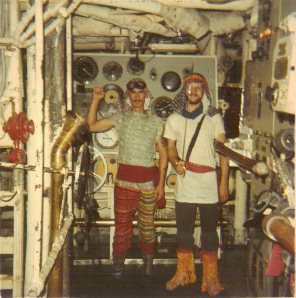 |
The "Official" ship's portrait. Gee.
 |
"The U.S.S Hugh Purvis"
I lived aboard the Hugh Purvis, DD 709, for over three years, from the summer of 1968 until the winter of 1971. Commissioned on March 1, 1945, the Hugh Purvis participated in the island-hopping part of World War 2 against the Japanese. An Allen M. Sumner class destroyer, 376 1/2 feet long and displacing 2,200 tons, she could do an honest 34 knots.
The six 5" 38 calibre dual-purpose guns were outdated for anti-aircraft use, yet were still good for shelling ships and land targets in 1968. We joined the battle at Tiger Island, off north Viet Nam, in the winter of 1968-1969 as the "bait" for communist heavy artillery. Shells roaring overhead and splashing all around us, we steamed into the range of those guns to draw their fire and thus give their locations away. LSMR's (rocket-firing landing craft), aircraft, and the 16" 50's of the battleship New Jersey, as well as our own guns and those of our little sisters (tin cans), bashed the heck out of those emplacements. It was at night, and the firing of all of those big guns and rockets lighted the sky. It was awesome.
The apparatus on the fantail (stern) was VDS, variable depth sonar. A fat torpedo-like sonar head was lowered on special cable to get below the inversion layer that might hide an enemy submarine from normal sonar. That, plus adding a point of reference in addition to the ship's normal sonar, helped to pinpoint the location. Then the DASH, drone anti-submarine helicopter, would be sent out with it's torpedo to kill the sub. These radio-controlled, counter-rotating bladed helicopters would sometimes get out of control and the Huey P would have to take evasive action. I know. I was in charge of damage-control, wearing the oxygen breathing apparatus, sound-powered phones, and holding the two-inch hose nozzle, the first man into the fire. Fortunately, these practice maneuvers never resulted in a fire, but sure came close on at least one occasion.
I was a machinest-mate, or snipe. I worked in the forward (main-control) engineroom and then the after engineroom. The turbines produced 60,000 shaft horsepower on two 14 foot, four-bladed, bronze, counter-rotating propellers. At only 350 rpm tops, the torque was incredible. Due to the force of 600 psi, superheated to 950 degrees farenheit steam, the torque curve was almost flat, meaning that at one rpm, the power was nearly the same as at 350 rpm. It was fun to be in control of so much sheer torque and power.
It was hot down in the "hole", as high as 140 degrees farenheit while crossing the equator. That's hot enough that your belt buckle would burn you. We just stood under the forced air blowers and sweated, drank lots of water and ate lots of salt tablets. Lots of coffee and cigarettes. Lots of BS.
We travelled all over the South Pacific in the winter of 1968 to 1969, visiting Honolulu, Hawaii, Midway, Guam, Sasebo, Japan, Olongapo, Phillippines, Brisbane, Australia, New Plymouth, New Zealand, Hong Kong, Singapore, China, and of course, Viet Nam. We also made a Mediterranean cruise in 1970, visiting Portugal, Barcelona, Spain, Palma, Majorca, Ismir and Istanbul, Turkey, Athens, Greece, Malta, Tunis, Tunisia, Naples, Italy, Sicily, Crete, and Cairo, Egypt. That was the best part of my Navy years, the travel.
"Jimmy Jet" Carr and myself in front of the throttleboard in the after engine room.
 |
The "Official" ship's portrait. Gee.
 |